|
|
|

Astrophytum caput-medusae
|
|
Description:
Solitary or rarely clustered up to 19 of eight.
Stem:
Very reduced, shortly
cylindrical, lacking
ribs, with
papyraceous
bristles covering the
collar and the stem
apex, the bristles probably
originate from the
basal rest
of the tubercles, the colour of the bristles of tubercles is coffee whit reddish tones, the stem bristle of plants growing in
habitat rarely exceed the
ground level.
Tubercles: Cylindrical or occasionally triangular when
young, of cartilaginous consistency, smooth, could appear
similar in aspect to leaves, up to 190 mm in length and of 2 to
5 mm wide, some times the
adaxial portion of the
base
of the tubercle
is
cuneate.
Epidermis
verrucose,
glaucous-green, covered by
stigmas (squamiform
peltate
trichomes) of a greyish-white colour, covering almost the
totality of the epidermis towards the base of the the tubercle.
Areoles :
Dimorphic; the
spiniferous one are
terminals,
circular or elliptical, with white
wool; the
floriferous one are
located in the
adaxial
subterminal portion, separated from the
spiniferous from 18 to 46 mm elliptical, with white wool, but
noticeably larger than the spiniferous areoles.
Spines:
0 up to 4, generally persisting in old tubercles, of 1 to 3 mm
in length,
semi-erect,
rigid, the base is whitish
with a dark-coffee apex.
Roots:
Primary root
fusiform, fleshy;
secondary roots
fibrous. The root is of the same dimension or slightly smaller
of the
aerial part.
Flowers: Originates in the
subterminal portion of the
developing tubercles, not in the plant
apex. The flowers are
diurnal, yellow, with the base of the inner
perianth
segments orange coloured. Outer segments greenish yellow,
The
receptacular tube displays
papyraceous,
lanceolate
scales,
with terminal
aristae and short white
hairs
in the
axil;
Lanceolate scales with white hairs in the axil are
also presents in the
pericarpel.
Fruit:
Green and
fleshy when young, covered with lanceolate scales with wool
in the axil, dry when
ripe
with irregular longitudinal
dehiscence.
Seeds: Big, up to 3 mm in length, cap-like,
testa
tuberculate , black or dark coffee coloured;
hilum
basal and very deep,
micropyle, outside the hilum, but adjacent.
|
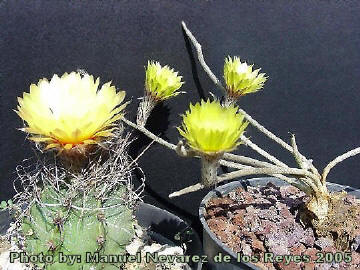
A. capricorne and A. caput-medusae
flowers
Photo kindly provided by Manuel Nevarez de los Reyes |
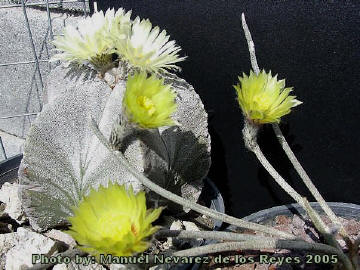
A.
myriostigma and A. caput-medusae
flowers
Photo kindly provided by Manuel Nevarez de los Reyes |
|
. |
|
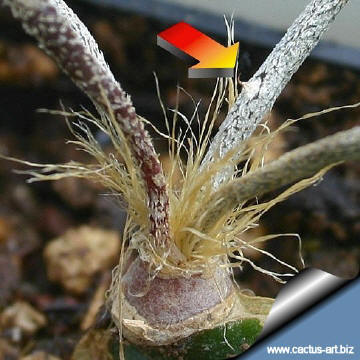
Long bristle and the first
adaxial areole. |
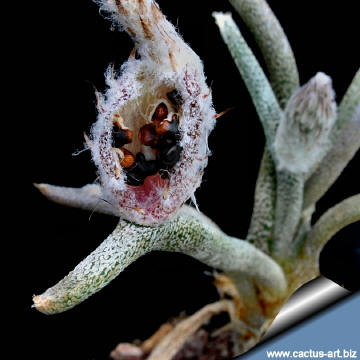
Fruit and seeds |
|
. |
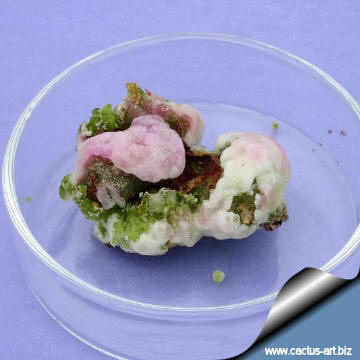
Micropropagation:
callus and... |
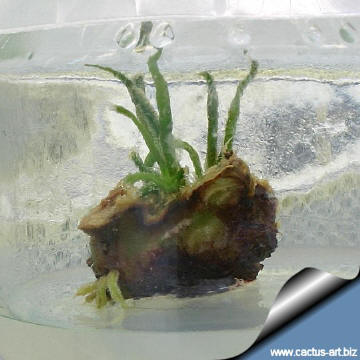
...the first
adventitious shoots. |
|
. |
|
Cultivation:The
specific requirements of this new and very particular plant
still need be
investigated.
In this two years we have done some preliminary
observation on a very limited sample of seedlings:
- The plants grow very
fast either grafted and on their own roots (possibly
grafting is not required)
- Grafted plants are
very sensible to drought, waterlessness for a few day conduct
(especially in summer) to a complete or partial loss of
tubercle that dry in a few hours, this seems due to the very
small proportion of the stem, and to the fact that the big tap
root (a water storage organ) is not present, in fact the
plants on their own roots are more stable and resistant.
Anyway the tubercles are deciduous they easily dry and detach
but are soon replaced by new one (a single tubercle can reach
maturity in a few week)
- Young seedlings
seem to need some light watering in winter, no damages or rot
has been evidenced for plants watered in winter.
- They prefer a
shaded or semi-shaded position as they live in habitat under
shrubs.
- All the few plant under observation stopped
to grow at the end of August, beginning a complete winter
dormancy. The first sign of new growth appeared only on the month
of march.
- The plant are quite resistant to frost
(during winter the green house temperatures varied from a minimum
of 0° C at night to a maximum of 25° C during sunny days) no sign
of damage has been signalized.
|
|


Advertising
|
|
|
|
|
Family:
Cactaceae
(Cactus
Family)
Conservation status: Listed in
CITES appendix 2.
Scientific
Name:
Astrophytum
caput-medusae
(Velazco & Nevarez) D. Hunt comb. nov. 2003
Published
in: HUNT, D. Cactaceae Systematic Initiatives, 15(4):1-2; 5-6, 2003
Astrophytum
subg. Stigmatodactylus D. Hunt nom. nov. 2003 (?)
Holotype:
Herbarium of the science
faculty - biology U.A.N.L. (UNL-023704)
Isotype:
Herbarium of the science
faculty - biology U.A.N.L. (UNL-023705), other material examined
UNL-023706, UNL-023707, UNL-023708.:
Author:
M. Nevárez de los Reyes M. and C. Velazco Macías
Type locality:
Mexico, Nuevo León,
Habitat:
Matorral espinoso tamaulipeco
Date:
August 28 2001
Basionym:
Digitostigma
caput-medusae
Velazco & Nevarez
Original
description in: VELAZCO, C.G.; NEVAREZ, M. Cact. Suc. Mex.
47(4):76-86, 2002
Synonyms: Digitostigma
caput-medusae
Velazco & Nevarez 2002
Etymology:
The
genus
name "Astrophytum"
derives from the Greek words "aster (αστηρ)",
meaning a "star" and "phyton (φυτον
)", meaning
"plant". ( The
Genus name implies:
"star plant").
The
species
name
"caput-medusae" derives from
the Latin
word “caput” which means “head” and
"Medusa (Μεδουσα)"
the Greek mythological woman whose blond hair was turned to snakes
and whose stare turn objects to stone, was slain by Perseus. ( The
specific name implies: "Medusa's head")
|
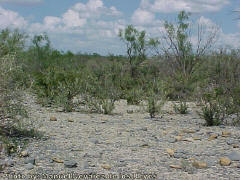 Distribution:
Mexico, Nuevo León (locality withheld) Distribution:
Mexico, Nuevo León (locality withheld)
Habitat:
Grows among shrubs in the
Matorral
espinoso tamaulipeco (Tamaulipan thornscrub land) in shaded
position.
|
|
|
|
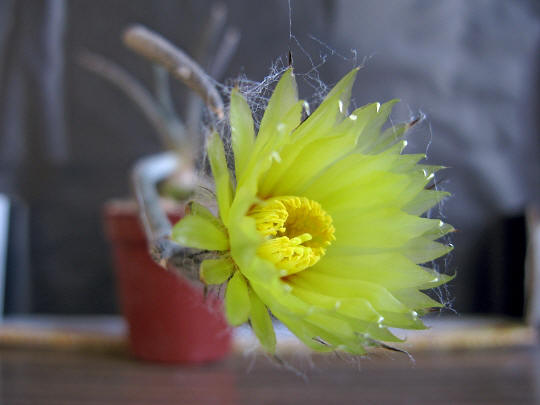
Photo kindly provided by Vadim, Moscow

The first flowers
bud.
|
|
Germination |
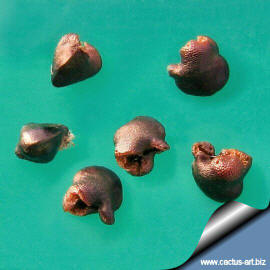
Seeds |
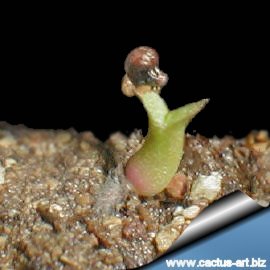
( One week ) Germination |

(2 weeks) First tubercle, woolly spines on the apical areoles. |
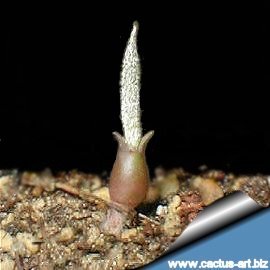
(40 days) The trichomes are evident. |
|
|